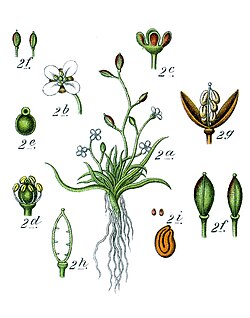This article needs additional citations for verification .(December 2024) |
| Subularia aquatica | |
|---|---|
 | |
| Illustration of Subularia aquatica | |
| Scientific classification | |
| Kingdom: | Plantae |
| Clade: | Tracheophytes |
| Clade: | Angiosperms |
| Clade: | Eudicots |
| Clade: | Rosids |
| Order: | Brassicales |
| Family: | Brassicaceae |
| Genus: | Subularia |
| Species: | S. aquatica |
| Binomial name | |
| Subularia aquatica | |
Subularia aquatica is an aquatic plant in the family Brassicaceae which is known by the common name water awlwort. This is a small herb with awl-like leaves (generally cylindrical but tapering to a sharp point), and growing from a corm above a network of bright white roots. Tiny flowers, each only about a millimeter long, are borne on stalks. Flowers which rise above the surface of the water open, while those that remain submersed stay closed and self-pollinate. The seeds come inside tiny inflated pods. There are two varieties of water awlwort; S. a. var. aquatica is native to Eurasia and S. a. var. americana is native to northern North America. There may also be a Mexican subspecies. This plant grows in ponds, marshes, peat bogs, and other shallow, cold water bodies, often in gravel or sand.
